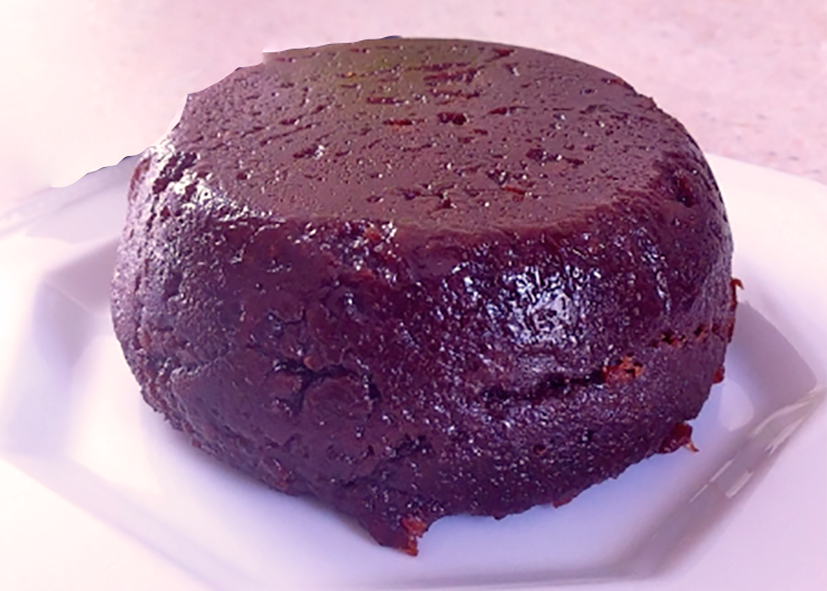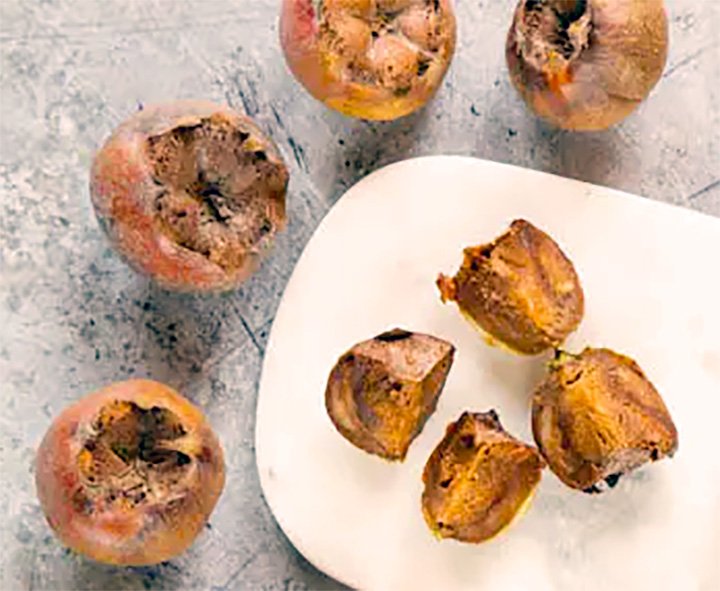
 Click on the image, above to submit to Pinterest.
Click on the image, above to submit to Pinterest.
Medlar Cheese and Medlar Purée
Medlar Cheese and Medlar Purée is a traditional British recipe (based on a medieval original) for a classic method of creating a purée and then a cheese from bletted medlar fruit. The full recipe is presented here and I hope you enjoy this classic Italian version of: Medlar Cheese and Medlar Purée.
prep time
20 minutes
cook time
50 minutes
Total Time:
70 minutes
Makes:
8
Rating: 
Tags : Spice RecipesBritish Recipes
This is basically a medieval recipe for a medlar paste; what would in modern terms be called a medlar cheese. The common medlar,
Mespilus germanica is the fruit of a large shrub or small tree in the rose family, Rosaceae. The fruit of this tree, also called medlar, has been cultivated since Roman times, is usually available in winter and eaten when bletted. The unusual thing about the medlar is that it does not and cannot ripen in the UK and should be collected as late in the Autumn as possible. As a result, they need to be removed from the tree, arranged on a large plate or tray, making sure they are not touching. Keep somewhere warm but out of the way (no need to be dark), possibly for a few weeks (typically 5 to 6), until soft and squeezable. This is the process of ‘bletting’. Once bletted, medlars make a fine fruit. Once bletted, medlar fruit can actually be eaten raw with a spoon and are quite delicious and unusual consumed this way.

Medlars, introduced by the Romans, used to be common in the UK and they were frequently consumed as a fruit in Medieval times (which is why there are a number of medieval recipes for them). However, the number of medlar trees have fallen dramatically and today they are most typically occasional plantings in gardens — which is a shame as this is a delicious fruit. They are best collected between late October and late November. When in season, specialist greengrocers might be able to source some and often they can be ordered on-line.
This recipe is based on a medieval original for medlar paste (actually medlar cheese in modern parlance); an excellent accompaniment to cheese. This is one of my typical home-made gifts for the family over Christmas.
The spicing here is modern, as allspice is from the New World. Ginger would have more commonly been used in medieval times. More sugar is also used than would have been available in Medieval times.
Ingredients:
Bletted medlars
500g sugar per 500g medlar puree
½ tsp ground allspice per 500g medlar puree
Method:
Where possible I like to start with at least 2kg of bletted medlars — you can start with less.
Roughly cut up the medlars and place in a bowl. Bring a saucepan of water to the boil then turn down to a simmer. Place the bowl of medlars on top of the saucepan, as for a bain marie (it should be sitting on the rim of the pan and the base should not touch the water). Cook until the medlars are well softened and can be mashed. This may take a while and you may need to top up the water in the pan.
When they are as soft as you can get them, push the medlars through a fine, but strong sieve (or use a mouli if you have one). You may need to use the end of a rolling pin to help get all the pulp through the sieve. This is your medlar puree, which you can use for a whole range of other medlar-based recipes. The left-over solids can be combined with a few mashed medlars to make Medlar Vinegar.
When you have pushed as much pulp through as possible through the sieve, weigh the resultant puree and mix with an equal weight of sugar and ½ tsp ground allspice per 500g of pulp.
Place the medlar, sugar and spice mix into a non-reactive pan and cook over a low heat, stirring constantly. Allow to bubble slowly until it has taken on a rich chocolate colour and is quite thick.
Lightly grease some small dishes or moulds and fill with this paste paste. Allow to cool then chill in the refrigerator. When chilled the paste should set. If it still seems a bit too wet then reduce further by simmering some more.

 Click on the image, above to submit to Pinterest.
Click on the image, above to submit to Pinterest.
